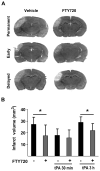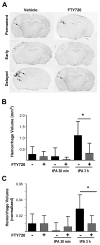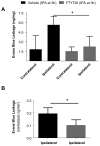Fingolimod reduces hemorrhagic transformation associated with delayed tissue plasminogen activator treatment in a mouse thromboembolic model
- PMID: 23287783
- PMCID: PMC3586809
- DOI: 10.1161/STROKEAHA.112.679043
Fingolimod reduces hemorrhagic transformation associated with delayed tissue plasminogen activator treatment in a mouse thromboembolic model
Abstract
Background and purpose: The sphingosine 1-phosphate receptor agonist fingolimod reduces infarct size in rodent models of stroke and enhances blood-brain barrier integrity. Based on these observations, we hypothesized that combination of fingolimod with tissue plasminogen activator (tPA) would reduce the risk of hemorrhagic transformation associated with delayed administration of tPA.
Methods: We evaluated the effects of fingolimod in a mouse model of thromboembolic stroke, in which both the beneficial effect of reperfusion associated with early tPA treatment and hemorrhagic transformation associated with delayed administration mimic clinical observations in humans.
Results: Our results demonstrate that fingolimod treatment attenuates the neurological deficit and reduces infarct volume after in situ thromboembolic occlusion of the middle cerebral artery. Combination of fingolimod and tPA improves the neurological outcome of the thrombolytic therapy and reduces the risk of hemorrhagic transformation associated with delayed administration of tPA.
Conclusions: This study confirms the protective efficacy of fingolimod as a treatment against ischemic stroke in another rodent model of stroke (thromboembolic occlusion), and suggests that fingolimod could potentially be used in combination with tPA to reduce the risk of brain hemorrhage.
Figures





Similar articles
-
IMM-H004 prevents toxicity induced by delayed treatment of tPA in a rat model of focal cerebral ischemia involving PKA-and PI3K-dependent Akt activation.Eur J Neurosci. 2014 Jun;39(12):2107-18. doi: 10.1111/ejn.12551. Epub 2014 Mar 20. Eur J Neurosci. 2014. PMID: 24649933
-
Pharmacological effects of the spin trap agents N-t-butyl-phenylnitrone (PBN) and 2,2,6, 6-tetramethylpiperidine-N-oxyl (TEMPO) in a rabbit thromboembolic stroke model: combination studies with the thrombolytic tissue plasminogen activator.Stroke. 2001 Jan;32(1):147-53. doi: 10.1161/01.str.32.1.147. Stroke. 2001. PMID: 11136930
-
Toll-Like Receptor 4 Mediates Hemorrhagic Transformation After Delayed Tissue Plasminogen Activator Administration in In Situ Thromboembolic Stroke.Stroke. 2017 Jun;48(6):1695-1699. doi: 10.1161/STROKEAHA.116.015956. Epub 2017 Apr 20. Stroke. 2017. PMID: 28428349
-
Antithrombotic Agents for tPA-Induced Cerebral Hemorrhage: A Systematic Review and Meta-Analysis of Preclinical Studies.J Am Heart Assoc. 2020 Dec 15;9(24):e017876. doi: 10.1161/JAHA.120.017876. Epub 2020 Dec 5. J Am Heart Assoc. 2020. PMID: 33283576 Free PMC article.
-
Mechanisms of hemorrhagic transformation after tissue plasminogen activator reperfusion therapy for ischemic stroke.Stroke. 2004 Nov;35(11 Suppl 1):2726-30. doi: 10.1161/01.STR.0000143219.16695.af. Epub 2004 Sep 30. Stroke. 2004. PMID: 15459442 Review.
Cited by
-
Combination of the Immune Modulator Fingolimod With Alteplase in Acute Ischemic Stroke: A Pilot Trial.Circulation. 2015 Sep 22;132(12):1104-1112. doi: 10.1161/CIRCULATIONAHA.115.016371. Epub 2015 Jul 22. Circulation. 2015. PMID: 26202811 Free PMC article. Clinical Trial.
-
Need for a Paradigm Shift in the Treatment of Ischemic Stroke: The Blood-Brain Barrier.Int J Mol Sci. 2022 Aug 22;23(16):9486. doi: 10.3390/ijms23169486. Int J Mol Sci. 2022. PMID: 36012745 Free PMC article. Review.
-
Impact of an immune modulator fingolimod on acute ischemic stroke.Proc Natl Acad Sci U S A. 2014 Dec 23;111(51):18315-20. doi: 10.1073/pnas.1416166111. Epub 2014 Dec 8. Proc Natl Acad Sci U S A. 2014. PMID: 25489101 Free PMC article. Clinical Trial.
-
Therapeutic Strategies to Attenuate Hemorrhagic Transformation After Tissue Plasminogen Activator Treatment for Acute Ischemic Stroke.J Atheroscler Thromb. 2017 Mar 1;24(3):240-253. doi: 10.5551/jat.RV16006. Epub 2016 Dec 13. J Atheroscler Thromb. 2017. PMID: 27980241 Free PMC article. Review.
-
Update on Inflammatory Biomarkers and Treatments in Ischemic Stroke.Int J Mol Sci. 2016 Nov 25;17(12):1967. doi: 10.3390/ijms17121967. Int J Mol Sci. 2016. PMID: 27898011 Free PMC article. Review.
References
-
- Hacke W, Kaste M, Bluhmki E, Brozman M, Davalos A, Guidetti D, et al. Thrombolysis with alteplase 3 to 4.5 hours after acute ischemic stroke. N Engl J Med. 2008;359:1317–1329. - PubMed
-
- Nicole O, Docagne F, Ali C, Margaill I, Carmeliet P, MacKenzie ET, et al. The proteolytic activity of tissue-plasminogen activator enhances nmda receptor-mediated signaling. Nat Med. 2001;7:59–64. - PubMed
-
- Cohen JA, Chun J. Mechanisms of fingolimod’s efficacy and adverse effects in multiple sclerosis. Ann Neurol. 2011;69:759–777. - PubMed
-
- Rodriguez C, Gonzalez-Diez M, Badimon L, Martinez-Gonzalez J. Sphingosine-1-phosphate: A bioactive lipid that confers high-density lipoprotein with vasculoprotection mediated by nitric oxide and prostacyclin. Thromb Haemost. 2009;101:665–673. - PubMed
Publication types
MeSH terms
Substances
Grants and funding
LinkOut - more resources
Full Text Sources
Other Literature Sources

